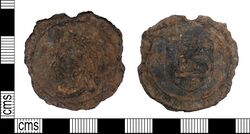Spelter
Topic: Chemistry
 From HandWiki - Reading time: 2 min
From HandWiki - Reading time: 2 min
Spelter is a zinc–lead alloy that ages to resemble bronze, but is softer and has a lower melting point. The name can also refer to a copper–zinc alloy (a brass) used for brazing, or to pure zinc.
Etymology
In his etymology of the English language, 19th-century philologist Walter William Skeat speculated that the word pewter might have been derived from spelter.[1]
Zinc–lead spelter
An inexpensive alloy that is easily cast and worked, spelter was used from the 1860s in the manufacture of candlesticks, clock cases, tableware, and light fixtures. In the early 20th century, sculptors such as Jacques Limousin used spelter heavily in their manufacture of Art Nouveau and Art Deco figurines and other ornaments.
Spelter is relatively soft and brittle. It can be distinguished from bronze by scratching its patina: untarnished spelter is white, while bronze is yellow.
The speltering process
Brass was made using a cementation process but this was replaced by speltering, the direct alloying of copper and zinc metal which was introduced to Europe in the 16th century.[2]
Other uses
Brasses containing zinc may be termed spelter, as may zinc ingots formed by smelting.
See also
- Chemistry:French Bronze – Bronze or a bronze-like finish
- Chemistry:Latten – Loose term for a variety of copper alloys used since the Middle Ages
- Chemistry:White metal – Type of decorative bright metal alloy
References
- ↑ Skeat, Walter William (1893). An etymological dictionary of the English language (2nd ed.). Oxford: Clarendon Press. pp. 438–439.
- ↑ Craddock, P.T. and Eckstein, K (2003) "Production of Brass in Antiquity by Direct Reduction" in Craddock, P.T. and Lang, J. (eds) Mining and Metal Production Through the Ages London: British Museum pp. 226–7
External links
 |
 KSF
KSF

